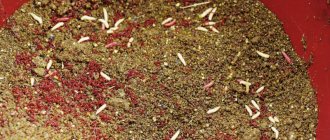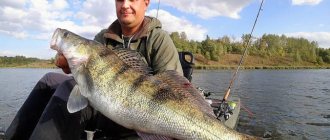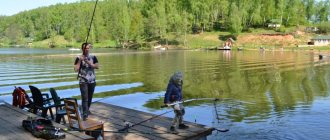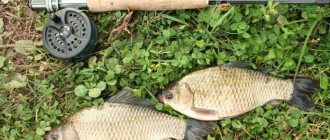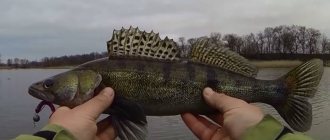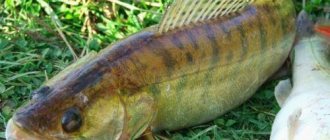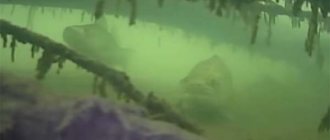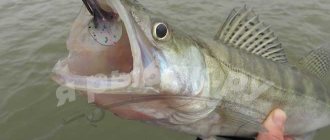Ways to catch pike perch
There are several most popular ways to catch pike perch in October:
- Fishing with spinners
- Jig fishing
- Trolling
- Plumb fishing from a boat
- Bottom fishing with live bait
Catching pike perch with spinners - this method has been known since Soviet times. Such lures for pike perch are quite easy to use, do not require much skill from the angler, and do not place any special demands on the shape of the rod or reel. However, given the weight of the spinners most often used for catching pike perch, it is worth classifying such fishing as light and ultralight fishing. In addition, they will sink into the bottom layer at great depths for too long, and the accuracy of the postings will be lost. Still, spinners work better at shallow depths and catch pike perch in the summer at night.
Choosing gear for autumn pike perch
The jerking power of the carp excludes a thin fishing rod, since the jerk is many times greater than the size of the fish itself. When going fishing, it is better to use proven gear so that the trip does not end before the scheduled time due to an incident.
The most versatile fishing rod for catching carp is the feeder. The rod shows good results in open water. A type of fishing rod with precise equipment will allow you to notice the fish at the right moment and make a hook.
Fishing rod elements
What you should know when choosing a rod for pike perch:
A high-rigidity rod up to 6 meters with guides is suitable for coastal fishing. A 2-meter fishing rod can be used from a boat;
- Balanced spinning reel;
- Strong fishing line or better cord to prevent chafing;
- Light-colored float (for better highlighting in cloudy water);
- The wiring is thinner than a fishing line or cord (from 25 cm in length);
- Sinkers matched to the weight of the float;
- Round short hook.
The main thing is to find a middle ground between reliability and invisibility. On the one hand, if you take a thin line, it can break under the pressure of prey. On the other hand, a cord that is too thick will scare away the fish. You will have to work hard to choose a line that is not thick and noticeable. At the same time, it is important to set the reel correctly; if the brake is too tight, then after several jerks the tackle will break.
Jig fishing
The most popular way of catching autumn pike perch among spinning anglers. It is used throughout the fall - in September, October and November. They practice fishing with silicone fry, brooms, silicone crayfish, mandula, and jig spinners. They fish with a classic jig loaded with a Cheburashka and with a drop-shot rig, which helps fish the pike perch holes centimeter by centimeter, finding a passive pike perch and forcing it to bite. Heads are used relatively rarely, since they involve more uniform wiring in the water column, and not playing with a knock on the bottom.
Fishing with a retractable leash
Fishing with a retractable leash is not used so often. This method is more suitable for catching perch. Those who want to have a small but stable catch in the autumn should try this type of fishing. In autumn, perch smothers fry in the coastal zone. You can catch some pretty good bast fish using a jig rig with a retractable leader. This will be great practice for a beginner who is taking his first steps in jig fishing. Microjig fishing for pike perch is practically not used. For microjig, lightweight baits are used that work in the water column, and it is better to catch pike perch with a jig running in steps along the bottom.
The following can be said about jig baits and their wiring. All lures are divided into two types - those that have their own game on a uniform retrieve, such as twisters and vibrotails, and those that have no or almost no such game, such as foam rubber, worms, octopuses. For the latter, be sure to use edible silicone or flavor impregnation. They are more often grabbed by passive pike perch, and can easily be spit out if it senses a catch. It is also desirable that all baits have a fluorescent color and are clearly visible in the underwater autumn haze.
Gear selection
Many anglers wait for autumn to go fishing for pike perch, considering this period to be the most successful . At the end of summer and early autumn there is a good bite, but the closer to winter, the more active the fish becomes. It has been noticed that the largest specimens are most often found in October or November.
Almost any gear can be used:
- spinning;
- rubber;
- donka;
- fishing rod and others.
Jig fishing with a spinning rod is considered popular and effective. The latter is a lead sinker with a hook. There is bait nearby. The name is derived from the English dance jig for the nature of the wiring used . This is the name given not only to the tackle itself, but also to the fishing method used.
Fishing for pike perch in late fall with a jig is especially effective due to the behavior of the pike perch. The fish is trying to gain fat for the winter and is actively moving around the reservoir. It can often be found on hills and in small creeks.
Rods used
The choice of rod for catching pike perch from the shore with a jig depends on the fishing location:
- In still water and in reservoirs, rods with a length of 3-3.3 m are used. If the shore is thick with bushes and trees, you should choose a little shorter: 2.4-2.7 m. Tests in both cases - from 5 to 30 g. For near edges can be a little less - 0−10 g.
- If the current is average, as, for example, on the Oka and Moscow rivers, the length of the rod will be the same, including with dense coastal vegetation. The test here is required a little higher - 7-40 g, in shallow water or in pits - 2-20 g.
- When fishing on the Volga, Akhtuba and other fast-flowing rivers, the length should be 3.3-3.6 m. The test is also longer - 20-150 g.
The listed requirements apply to jig fishing from the shore. If you plan to fish from a boat, the rod should be shorter - 1.8−2.7 m. However, the test indicators remain the same. If there are no long casts or fishing at significant depths, they can be reduced a little.
Trolling
Trolling is a fishing method that helps you quickly find active fish in a large area and provoke them to bite. It is very effective when searching for fish trails, as it allows you to find them in a short time over a large area. However, to successfully troll you need a good boat and a good motor. You need a four-stroke engine, which usually requires a permit, because fishing with a two-stroke under your ear all day can ultimately cause not pleasant fatigue, but a nervous breakdown.
They are caught by trolling with deep-sea wobblers. Be sure to use an echo sounder to timely track changes in the bottom, speed up or slow down the bait so that it runs approximately parallel to the bottom. A good echo sounder will show not only the fish and the bottom, but also the position of the wobbler if it is no more than 30 meters from the boat.
Plumb fishing
Plunge fishing will also require a boat. However, a powerful motor is not required in this case. For fishing, a side rod and a winter type balancer are used, but slightly larger and in a luminous color. When fishing, they try to determine the position of the fish using an echo sounder. Then, along the entire length of this flock, they follow, keeping the boat at a very low speed and correcting the course with the help of rare oar strokes, using a water parachute or an electric motor. When moving, they swing the rod, playing with the balancer and tempting the pike perch to take the bait. Even if the echo sounder shows not a pike perch, but a white fish, most likely a predator is following this school.
Fishing technique and tactics
Pike perch is a very capricious fish that can be very active and lively. That is why, if you have no experience in catching it, you should take into account several basic recommendations.
Many fishermen who often visit the Volga to catch this predator claim that it is the stepped fishing that allows them to achieve better results.
The main recommendations are as follows:
- The cast is carried out at a distance of 70-100 meters, depending on the characteristics of the pre-selected area.
- At the moment the bait touches the water, the tip is pointed upward, which determines the tension of the cord. After the bait reaches the bottom, the braid will weaken.
- Stepped wiring involves making several turns of the coil, after which a pause is left. It is at this moment that the selected bait sinks to the bottom again. The attack from the fish occurs when the bait is lowered and moved in steps.
- The moment of the bite is reflected on the tip of the rod. At this moment, it is recommended to sharply hook the predator. Uncertain movements can cause the fish to simply throw away the bait and move on. However, too strong an untimely jerk can also cause the pike perch to fall off, so it is important to choose the right moment for hooking.
Biting and fishing
- At the time of fishing, you have to dampen the powerful jerks of the predator, which can resist throughout the entire period.
- The cord must be constantly taut, which does not allow the prey to make sudden jerks.
- After the fish appears near the side of the boat, you should let it take a breath and the pike perch weakens, take it by the gills with your hand.
- To increase the catch, a swivel with a clasp is often used on the leash. Due to this minor modification, it becomes possible to quickly change the bait depending on the prevailing conditions without wasting time.
Fishing with live bait
Fishing with live bait in October is usually practiced by those who catch burbot. This can be fishing with a line, with a donk with an elastic band, or with a cast. It is worth remembering that most live bait does not tolerate long-distance casting of the bottom into the water and may simply die due to concussion. Fish are reluctant to take such dead bait. Therefore, a net and an elastic band are suitable for live bait bottom fishing. They allow you to deliver live bait to depth smoothly, without dizzying flights through the air followed by a blow.
When fishing this way, most often the catch will be burbot. But you can also successfully catch pike perch if you set the line so that most of the hooks go along its path, discovered earlier. There is a chance that when checked, all of them will be hung with valuable fanged trophies and no less valuable with a mustache on their chin.
Sometimes, especially in areas rich in fish, in Astrakhan, in Akhtuba, in the lower reaches of the Volga, you can see autumn fishing for pike perch with mugs. Of course, if you have a boat. Practice in more northern regions shows that pike often take to circles, and best of all in the summer, not pike perch in autumn. However, if you have free time, you can try this method of live bait fishing. An echo sounder in a fisherman’s arsenal has long made mugs not as effective as a spinning rod. It allows you to purposefully follow a school of fish, rather than wait for a bite along a wide front of spaced circles. And you’ll have to chase them all over the lake, exhausted behind the oars or the roar of the engine.
Catching pike perch on a donk
Casting over a long distance is ensured by a spinning or feeder rod with a test for the weight of the sinker used. The bite indicator is a bell attached to the tip of the rod.
Any convenient coil can be installed. It is better to use inertia-free models with a baitrunner. This is especially true when fishing with live bait.
Donkey rig for pike perch
An important role is played by the donkey rig for pike perch. The equipment is applicable with or without a feeder. A special feature of the equipment is a retractable leash.
Sequence of mounting a donkey on a pike perch:
- Take a piece of fishing line 0.7-1.0 m long.
- Attach a carabiner to one end. It is necessary for quickly replacing the sinker.
- Form a hanging loop in the selected location. If you plan to catch pike perch on a river donka, then the loop is knitted at a distance of 15-30 cm from the sinker. In the absence of current, it is advisable to increase the distance to 50-60 cm.
- Tie the hook to the outlet leash with a fishing knot.
Note: the diameter of the leader is 10% thinner than the main line.
- A branch leash with a length of 40 cm to 1 m is tied in a loop-to-loop manner. You can use any other convenient knot.
- At the other end of the fishing line, tie a swivel. Using a swivel, which acts as an anti-twist, the equipment is tied to the main fishing line.
Fishing Features
When using a donkey with a feeder, you should take care of the filler. You can attract pike perch with dry blood, fish minced in a meat grinder, or pellets for bait. To give the complementary food the necessary viscosity, you can use fishing glue and various astringent additives.
Bait for pike perch:
- Live bait: gudgeon, bleak, small crucian carp or roach;
- Sliced fish;
- Unsalted fresh sprat. Can be replaced with fresh frozen small fish;
- A bunch of bloodworms or worms. To prevent the bloodworm from leaking out, bundles of it are prepared in advance and tied to the hook during the fishing process.
After casting, the rod is placed on a high stand at an angle of 60-80 degrees. If the reel is equipped with a baitrunner, then it must be turned on. Don't rush into hooking. It is necessary to wait 5-10 seconds and allow the predator to securely capture the bait. When using other bait, the wait time should be minimal. A sharp cut is performed. When fishing, it is necessary to control the constant tension of the fishing line. If the reel clutch begins to “crackle,” then you need to try to tire out the large fish that has been hooked. It is pulled ashore with a landing net.
